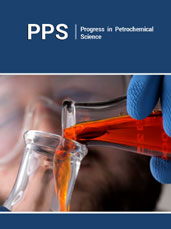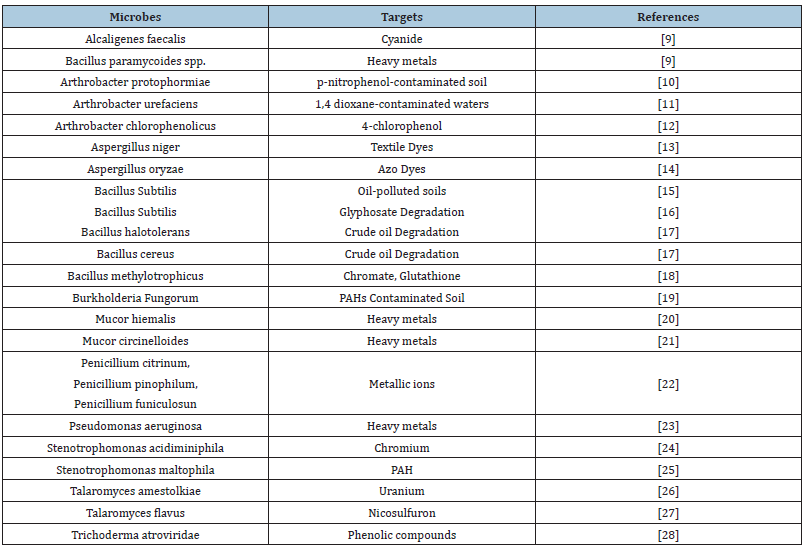- Submissions

Full Text
Progress in Petrochemical Science
Microorganisms Capable of Bioremediation
Sina Akan Gümüşburun* and İbrahim Halil Kiliç
Department of Biology, University of Gaziantep, Turkey
*Corresponding author:Sina Akan Gümüşburun, Department of Biology, University of Gaziantep, Turkey
Submission: October 17, 2023;Published: October 31, 2023

ISSN 2637-8035Volume5 Issue5
Abstract
The environment is contaminated by different types of waste and it is a big threat for the earth. The increase of population and request for industrial organization revealed pollution in land, air, water environment. Industrial, domestic and hospital effluents contain textile dyes, heavy metals, petroleum oil, PAHs and cancer-causing amines. Petroleum oil, heavy metal, dyes contaminated wastewater is a hazard for the environment and especially marine ecosystem. Bioremediation is a good way to heal our environment. Bioremediation by microorganism is eco-friendly, effective and cheap. This mini review put forward the microorganism which is efficient on bioremediation.
Keywords:Bioremediation; Microorganism; Waste
Introduction
Petroleum refinery effluents were produced from the crude oil, fuel processing and industries [1]. Also industrial, hospital and domestic effluents can easily create contaminated soil. These effluents are an important cause of contamination in the natural ecosystem, especially are a huge threat for environment. Petroleum oils have ingredients which are toxic to plants, animals, human health [2]. Bioremediation is a biological mechanism that utilizes the metabolic potential of microorganisms to clean up contaminated environments [3]. It is a microbiological process which converts contaminates to nontoxic or less toxic elemental and compound forms. Meanwhile It is used hydrocarbons as energy and food sources for reproduction and growth. During biodegradation, the hydrocarbons are mineralized to carbon dioxide and water. However, this process does not always consist because of the difference of efficient factors of biodegradation [3]. Bioremediation and biodegradation are close terms [4]. Microorganisms can be effective for bioremediation processes to eliminate and modify pollutants [5] microorganisms have a significant role for pollutant removal tools in soil, water and sediments [4]. Natural microbes and cultivated in the laboratory, both of them can be used in bioremediation process. These microorganisms are bacteria, yeasts, molds, fungi, algae and some plants. Many bacterial species have the ability to degrade oil [2]. Thanks to its high efficiency, cheapness, microorganism-originated bioremediation is counted as a promising and inventive method to reduce contamination [6].
Microbial Bioremediation
Microorganisms have an essential role in human health and are also important for ecological balance [6]. Bioremediation is comprised of degrading, removing, altering, immobilizing, or detoxifying wastes from the environment with the help of the bacteria, fungi. Many microbial genera have been known to be counted in bioremediation, including Alcaligenes, Arthrobacter, Aspergillus, Bacillus, Burkholderia, Mucor, Penicillium, Pseudomonas, Stenotrophomonas, Talaromyces and Trichoderma [7]. Chemical contaminants can be used by microorganims as an energy source via their metabolic process [8]. Table 1 shows us the strains of some species that are commonly used for bioremediation resolutions.
Table 1:Diversity of microorganisms.

Conclusion
This paper reviews species of microbes and their targets for bioremediation. The earth’s biggest problem is pollution and it is getting worse each day. Bioremediation through microbes is a potent solution to clean up pollution. The research shows us bioremediation provides the achievement of clean water. In previous works isolated strains have been shown to play an important role in bioremediation by degrading heavy metals, petroleum oil, chemicals. The major problem these days is pollution and the best solution is bioremediation by microbes can be the best solution.
References
- Rahi MN, Jaeel AJ, Abbas AJ (2021) Treatment of petroleum refinery effluents and wastewater in Iraq: A mini review. Materials Science and Enginnering 1058.
- Kilic IH, Iyidogan AK, Aaazi NA, Oguzkan SB, Ozaslan M (2018) Bioremediation of wastewater contaminated with petroleum hydrocarbons from Baiji thermal power station in Iraq. Fresenius Environmental Bulletin 27(8): 5223-5229.
- Watanebe K (2001) Microorganisms relevant to bioremediation. Current Opinion in Biotechnology 12(3): 237-241.
- Abatenh E, Gizaw B, Tsegaye Z, Wassie M (2017) The role of microorganisms in bioremediation-a review. Open Journal of Environmental Biology.
- Jain M, Khan SA, Sharma K, Jadhao PR, Pant KK, et al. (2022) Current perspective of innovative strategies for bioremediation of organic pollutants from wastewater. Bioresource Technology 344: 126305.
- Yin S, Zhang X, Yin H, Zhang X (2022) Current knowledge on molecular mechanisms of microorganism-mediated bioremediation for arsenic contamination: A review. Microbiological Research 258: 126990.
- Kour D, Kaur T, Devi R, Yada A, Singh M, et al. (2021) Beneficial microbiomes for bioremediation of diverse contaminated environments for environmental sustainability: Present status and future challenges. Environmental Science and Pollution Research 28(20): 24917-24939.
- Tarekegn MM, Salilih FZ, Ishetu AI (2020) Microbes used as a tool for bioremediation of heavy metal from the environment. Food and Science Technology 6: 1783174.
- Rashid A, Mirza SA, Keating C, Ali S, Campos LC (2022) Indigenous Bacillus paramycoides and Alcaligenes faecalis: Sustainable solution for bioremediation of hospital wastewater. Environmental Technology 43(12): 1903-1916.
- Labana S, Singh OV, Basu A, Pandey G, Jain RK (2005) A microcosm study on bioremediation of p-nitrophenol-contaminated soil using Arthrobacter protophormiae RKJ100. Appl Microbiol Biotechnol 68(3): 417-424.
- Zhu J, Zhao Y, Liu Z, Li X, Meng Z (2020) Application of a simazine degrading bacterium, Arthrobacter ureafaciens XMJ-Z01 for bioremediation of simazine pollution. Water and Environment Journal 34(S1): 561-572.
- Backman A, Maraha N, Jansson JK (2004) Impact of temperature on the physiological status of a potential bioremediation inoculant, Arthrobacter chlorophenolicus A6. Applied and Environmental Microbiology 70(5): 2952-2958.
- El-Rahim WM, El-Ardy OA, Mohammad FH (2009) The effect of pH on bioremediation potential for the removal of direct violet textile dye by Aspergillus niger. Desalination 249(3): 1206-1211.
- Corso CR, Almeida AC (2008) Bioremediation of dyes in textile effluents by Aspergillus Microbial Ecology 57(2): 384-390.
- Cubitto MA, Moran AC, Commendatore M, Chiarello MN, Baldini MD, et al. (2004) Effects of bacillus subtilis O9 biosurfactant on the bioremediation of crude oil-polluted soils. Biodegradation 15(5): 281-287.
- Yu XM, Yu T, Yin GH, Dong QL, An M, et al. (2015) Glyphosate biodegradation and potential soil bioremediation by bacillus subtilis strain Bs-15. Genetics and Molecular Research 14(4): 14717-14730.
- Deng Z, Jiang Y, Chen K, Gao F, Liu X (2020) Petroleum depletion property and microbial community shift after bioremediation using bacillus halotolerans T-04 and bacillus cereus 1-1. Frontiers in Microbiology 11: 353.
- Mala GS, Sujatha D, Rose C (2015) Inducible chromate reductase exhibiting extracellular activity in bacillus methylotrophicus for chromium bioremediation. Microbiological Research 170: 235-241.
- Andreolli M, Lampis S, Zenaro E, Salonen MS, Vallini G (2011) Burkholderia fungorum DBT1: A promising bacterial strain for bioremediation of PAHs-contaminated soils. FEMS Microbiology Letter 319(1): 11-18.
- Hoque E, Fritscher (2019) Multi-metal bioremediation and biomining by a combination of new aquatic strains of Mucor hiemalis. Scientific Reports 9: 10318.
- Zhang S, Gedalanga B, Mahendra S (2017) Advances in bioremediation of 1,4-dioxane-contaminated waters. Journal of Environmental Enginnering 204(2):765-774.
- Martins LR, Lyra FH, Rugani MM, Takahashi JA (2015) Bioremediation of metallic ions by eight Penicillium Journal of Environmental Enginnering 142(9).
- Chellaiah ER (2018) Cadmium (heavy metals) bioremediation by pseudomonas aeruginosa: A minireview. Applied Water Science 8: 154.
- Liu SH, Zeng GM, Niu QY, Liu Y, Zhou L, et al. (2017) Bioremediation mechanisms of combined pollution of PAHs and heavy metals by bacteria and Fungi: A mini review. Bioresource Technology 224: 25-33.
- Gurjeet P, Kothiyal NC, Kumar V (2014) Bioremediation of some polycyclic aromatic hydrocarbons (PAH) from soil using sphingobium indicum, sphingobium japonicum and stenotrophomonas maltophilia bacterial strains under aerobic conditions. Journal of Environmental Research and Development 8(3): 395-405.
- Coelho E, Reis TA, Cotrim M, Mullan TK, Renshaw J, et al. (2022) Talaromyces amestolkiae uses organic phosphate sources for the treatment of uranium-contaminated water. Biometals 35(2): 335-348.
- Song J, Gu J, Zhai Y, Wu W, Wang H, et al. (2013) Biodegradation of nicosulfuron by a Talaromyces flavus LZM1. Bioresource Technology 140: 243-248.
- Chakroun H, Mechichi T, Martinez MJ, Dhuoib A, Sayadi S (2010) Purification and characterization of a novel laccase from the ascomycete Trichoderma atroviride: Application on bioremediation of phenolic compounds. Process Biochemistry 45(4): 507-513.
© 2023 Sina Akan Gümüşburun. This is an open access article distributed under the terms of the Creative Commons Attribution License , which permits unrestricted use, distribution, and build upon your work non-commercially.
 a Creative Commons Attribution 4.0 International License. Based on a work at www.crimsonpublishers.com.
Best viewed in
a Creative Commons Attribution 4.0 International License. Based on a work at www.crimsonpublishers.com.
Best viewed in 







.jpg)






























 Editorial Board Registrations
Editorial Board Registrations Submit your Article
Submit your Article Refer a Friend
Refer a Friend Advertise With Us
Advertise With Us
.jpg)






.jpg)













.bmp)
.jpg)
.png)
.jpg)














.png)

.png)



.png)






